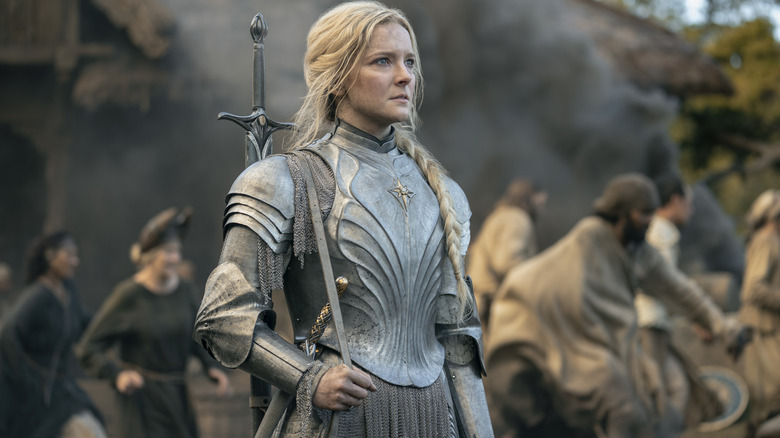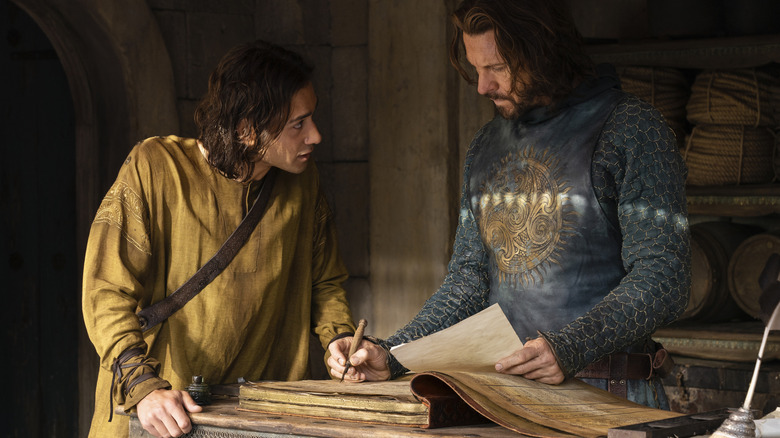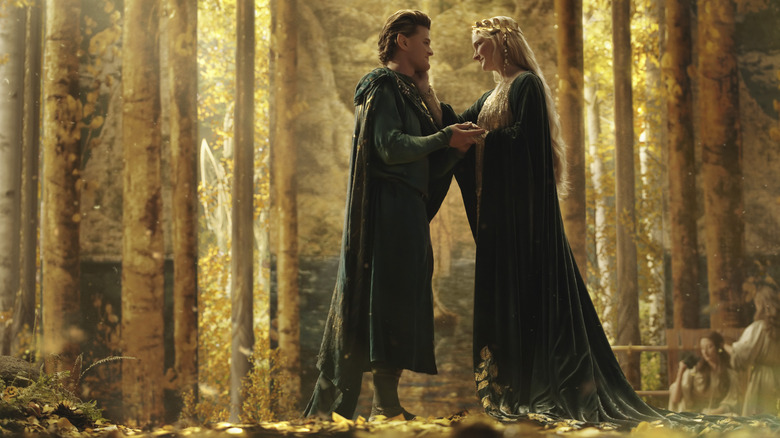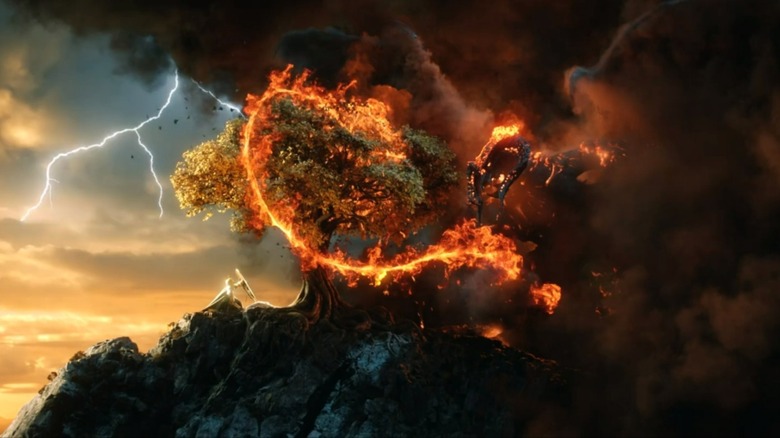
Warriors have their swords, wizards have their walking sticks, and harfoots have their, well, hairy feet. But for those of us on the outside looking in at fantastical shows like "The Lord of the Rings: The Rings of Power," we may have nothing but questions about how exactly this sprawling story in season 1 came together to begin with. The endless handwringing over fidelity to author J.R.R. Tolkien's work and whether this story truly "feels like Tolkien" enough have driven plenty of headlines, but there may remain some confusion over just what source material "The Rings of Power" is adapting in the first place and how exactly this new story is meant to fit into the vast legendarium.
The short answer? Unlike Peter Jackson's "The Lord of the Rings" (or even other fantasy contemporaries, like the ongoing "House of the Dragon"), series creators J.D. Payne and Patrick McKay didn't have the benefit of any single text to draw upon in order to build out their scripts. More to the point, this show technically exists in a separate continuity altogether from Jackson's acclaimed trilogy of movies — a legal obstacle that makes many of the shared characters, locations, and even designs between "The Lord of the Rings" and "The Rings of Power" that much more complicated. The long answer, then? Well, that would require clearing up the muddied water surrounding most discussions of this fascinating and relatively complicated take on Middle-earth.
So for those who may not know their "Silmarillion" from Sauron — and even for those who do — consider this a handy explainer rounding up all the information we know about "The Lord of the Rings: The Rings of Power," the specific Tolkien writing it's adapting, and how it conquered its toughest foe yet: those pesky rights issues.
What Did Amazon Buy Anyway?

It's the million-dollar question — $250 million, actually. When Amazon Studios first purchased the television rights to create what would eventually become "The Rings of Power," the news inspired hot takes, kneejerk reactions, and no shortage of eyebrow-raising questions.
Hesitant fans immediately wondered what material this show could even adapt in the first place. Such skepticism came from the knowledge that the Tolkien Estate — the notoriously hard-to-please legal entity considered to be custodians and caretakers of Tolkien's legacy — jealously guard the rights to "The Silmarillion" under lock and key, preventing it from being adapted in any form after the Tolkien family felt jilted by the liberties Peter Jackson took with his film trilogy. This meant that the author's golden goose, a veritable treasure trove of epic poems and tales depicting events taking place long before "The Lord of the Rings," remains strictly off-limits.
Instead, Amazon's deal clearly defined the parameters of what could and couldn't be translated to the small screen. To do this, Payne and McKay had to turn to alternative sources. As the showrunners once explained:
"We have the rights solely to 'The Fellowship of the Ring,' 'The Two Towers,' 'The Return of the King,' the appendices, and 'The Hobbit.' And that is it. We do not have the rights to 'The Silmarillion,' 'Unfinished Tales,' 'The History of Middle-earth,' or any of those other books."
So the writers resorted to loopholes: adapting "The Lord of the Rings" chapters where characters reference historical events that took place in the First and Second Ages and, more than anything else, the lengthy appendices included at the end of "The Return of the King" that went into greater detail and provided the basis for "The Rings of Power."
Wait, So The Rings Of Power Isn't A Prequel To The Movies?

When is a prequel not actually a prequel? When the complicated ins and outs of Tolkien rights come into play.
Despite common misconceptions that "The Rings of Power" and Peter Jackson's groundbreaking "The Lord of the Rings" movies are canonical with one another — understandably so, give several shared characters, many of the same locations, and even certain examples of creature design — "The Rings of Power" is prohibited from existing within the same exact continuity. Unable to contradict or add to anything that Jackson did with his films (which explains why Amazon abruptly backed away from bringing the director on board as a consultant in any capacity whatsoever), the series instead must stand on its own two feet rather than function as a traditional prequel.
Admittedly, this doesn't really affect the viewing experience of "The Rings of Power" all that much since both properties are rooted in the same source material, which means there are ample opportunities for clever retconning.
Familiar characters like Elrond and Galadriel, portrayed by Robert Aramayo and Morfyyd Clark respectively, are known quantities to those who watched Hugo Weaving and Cate Blanchett play different (and much older) versions of those characters in "The Lord of the Rings." The fact that they aren't literally the same heroes we saw before, however, shouldn't make much of a difference to anyone except the biggest lore obsessives. Their characterizations still draw upon how Tolkien originally envisioned them, which means it's fair game to compare their younger selves in the show with how the movies interpreted them much later on in their lives.
The showrunners addressed this as well, citing a mandate of "different but familiar" in taking inspiration from Jackson's Middle-earth without staying beholden to it.
Bending The Rules

After all this talk about how ironclad and constricting this rights situation is for "The Rings of Power," however, it's worth noting that not all aspects of this Amazon deal seem to be as intractable and nigh indestructible as the One Ring itself.
Consider the very glaring fact that, despite taking place in a separate continuity entirely, certain aspects of "The Rings of Power" appear to be pulled straight from Jackson's "The Lord of the Rings" movies. For one thing, the Amazon series brought back artists such as composer Howard Shore, concept artist John Howe, and others who were involved with the original movies, adding more confusion to the proceedings through this shared DNA. But much more noticeably, several character and creature designs — from the look of Sauron himself (as glimpsed briefly early in the premiere) to the fiery balrog to even invoking certain "Silmarillion"-exclusive lore (as noted by Collider) — are exactly as they appear in material outside of Amazon's purview.
How to explain the studio's apparent flouting of their own deal?
Well, consider that the show's creatives worked closely with Tolkien Estate director and Tolkien's own grandson, Simon Tolkien, throughout the process. This unprecedented collaboration, previously unheard-of in the history of the Tolkien Estate and its tumultuous relationship with previous adaptations, almost certainly thawed the frost between both parties and allowed for a relaxing of the rules. This seems to have been alluded to in a recent Variety profile of Amazon Studios head Jennifer Salke, who remarked on Simon Tolkien's work on the series and that "...the estate was very open and encouraging for reinvention, but always in ways that stay true to Tolkien. We all have the same kind of vision for this property. There was never any disconnect there, which is probably why it worked out so well."
This partnership seems to have worked out so far on "The Rings of Power," giving us a thrilling and unique fantasy story that — complicated rights issues and all — should provide even more excitement to come.
Read this next: 13 Fantasy Shows Like The Lord Of The Rings: The Rings Of Power You Should Check Out
The post What Can The Rings of Power Adapt? A Guide to The Lord of the Rings' Rights Issues appeared first on /Film.
0 Comments